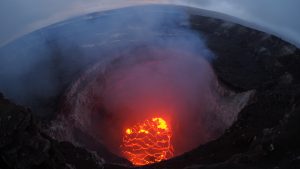
Public domain (https://www.usgs.gov/news/kilauea-volcano-erupts)
The recent eruption of the Kilauea volcano in Hawaii had a devastating impact on the island. However, it appears that the lava that reached the Pacific Ocean may have created conditions ideal for a phyloplankton boom in the ocean.
The lava was around 2,100 degrees Fahrenheit, far too hot for living things to flourish. But what happened in this case is that as the lava went deeper into the water, it heated nutrient-rich waters and pushed them toward the surface, which provided food for the local phyloplankton populations. When the lava stopped heating the water, the phyloplankton populations shrunk back to their normal size.
Of course, the scientist studying this phenomenon wanted more data, so they attempted to recreate the conditions in their labs. With the help of artists, they melted hardened lava rock and poured it into seawater to see if they could get a similar phyloplankton boom. Though this experiment didn’t create the desired effect, it gave them more ideas on where to look next for answers.
You can read more about this here!
Follow us online: